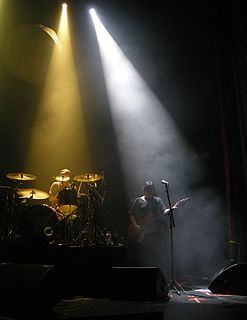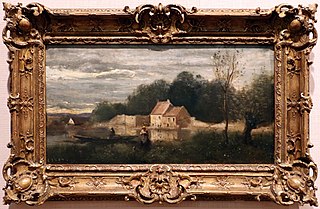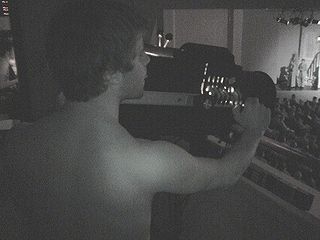
Stage lighting is the craft of lighting as it applies to the production of theater, dance, opera, and other performance arts. Several different types of stage lighting instruments are used in this discipline. In addition to basic lighting, modern stage lighting can also include special effects, such as lasers and fog machines. People who work on stage lighting are commonly referred to as lighting technicians or lighting designers.

Cinematography is the art of motion-picture photography and filming either electronically by means of an image sensor, or chemically by means of a light-sensitive material such as film stock.
Electrical lighting technicians (ELT) or simply lighting tech., are involved with rigging stage and location sets and controlling artificial, electric lights for art and entertainment venues or in video, television, or film production.

République is a station of the Paris Métro, serving lines 3, 5, 8, 9, and 11. It is located under the Place de la République, at the limit of the 3rd, 10th and 11th arrondissements of Paris.

A spotlight is a powerful stage lighting instrument which projects a bright beam of light onto a performance space. Spotlights are controlled by a spotlight operator who tracks actors around the stage. Spotlights are most commonly used in concerts, musicals and large scale presentations where highlighting a specific mobile individual is critical. Spotlights are sometimes located overhead on catwalks. In some theatres, they may also be located in the control booth or purposely built "spot booths" in addition to the catwalk.

Mechanical television or mechanical scan television is a television system that relies on a mechanical scanning device, such as a rotating disk with holes in it or a rotating mirror, to scan the scene and generate the video signal, and a similar mechanical device at the receiver to display the picture. This contrasts with modern television technology, which uses electronic scanning methods, for example electron beams in cathode ray tube (CRT) televisions, and liquid-crystal displays (LCD), to create and display the picture.

Ellipsoidal reflector light is the name for a type of stage lighting instrument, named for the ellipsoidal reflector used to collect and direct the light through a barrel that contains a lens or lens train. The optics of an ERS instrument are roughly similar to those of a 35 mm slide projector. There are many types of ERS that are designed for the myriad applications found in the entertainment industry. ERS instruments come in all shapes and sizes. Each particular model of ERS has its own set of characteristics. Generally, ERS instruments are the most varied and utilized type of stage lighting instrument. ERS may also be referred to as Profile Spotlights because the beam can be shaped to the profile of an object. Ellipsoidal reflectors are used for their strong, well-defined light and their versatility. Leko and Source Four are brand names which are often, but inaccurately, used to refer to any sort of ellipsoidal.

A picture frame is a simultaneously protective and decorative edging for a picture, such as a painting or photograph. It makes displaying the work safer and easier and both sets the picture apart from its surroundings and aesthetically integrates it with them.

A motion picture film scanner is a device used in digital filmmaking to scan original film for storage as high-resolution digital intermediate files.

A parabolic aluminized reflector lamp is a type of electric lamp that is widely used in commercial, residential, and transportation illumination. It produces a highly directional beam. Usage includes theatrical lighting, locomotive headlamps, aircraft landing lights, and residential and commercial recessed lights.

Intelligent lighting refers to stage lighting that has automated or mechanical abilities beyond those of traditional, stationary illumination. Although the most advanced intelligent lights can produce extraordinarily complex effects, the intelligence lies with the human lighting designer, control system programmer, or the lighting operator, rather than the fixture itself. For this reason, intelligent lighting is also known as automated lighting, moving lights, moving heads, or simply movers.

Stage lighting instruments are used in stage lighting to illuminate theatrical productions, concerts, and other performances taking place in live performance venues. They are also used to light television studios and sound stages.

The spotlight operator or followspot operator is a theatrical technician who operates a specialized stage lighting instrument known as a followspot. A followspot is any lighting instrument manually controlled by an operator during a performance. Generally a followspot will be a dedicated, large lighting instrument designed to pan and change size, beam width, and color easily by hand.
A colour scroller or colour changer is an electro-mechanical lighting accessory used in theater, film, dance and concerts to change the colour projected by stage lighting instruments without the need of a person to be in the vicinity of the light. A colour scroller moves plastic "gel" colour gel [actually dyed polyester and/or other base materials coated with dyes] into the beam of the light. It is generally attached to the gel frame holder at the transmitting end of a lighting fixture, so colour is introduced after the beam characteristics have been defined by the optics of the lighting instrument. Most scrollers are controlled via DMX512 protocol, but some models also utilize the RDM protocol. When colour scrollers were first introduced around 1980, a number of companies produced them, including: Avolites, GAM Products, Morpheus Lights, Rainbow, Rosco Laboratories and Wybron Inc. Now the main manufacturers are: A.C. Lighting, Apollo, Morpheus Lights and Rainbow.

The Nikon D300 is a 12.3-megapixel semi-professional DX format digital single-lens reflex camera that Nikon Corporation announced on 23 August 2007 along with the Nikon D3 FX format camera. It replaced the D200 as Nikon's DX format flagship DSLR. The D300 was discontinued by Nikon on September 11, 2009, being replaced by the modified Nikon D300S, which was released July 30, 2009. The D300S remained the premier Nikon DX camera until the D7100 was released in early 2013.
Stage lighting accessories are components manufactured for conventional (non-automated) stage lighting instruments. Most conventional fixtures are designed to accept a number of different accessories designed to assist in the modification of the output. These accessories are intended to either provide relatively common functionality not originally provided in a fixture, or to extend the versatility of a lighting instrument by introducing features. Other accessories have been designed to overcome limitations or difficulties some fixtures present in specific applications.

The Nikon D7000 is a 16.2-megapixel digital single-lens reflex camera (DSLR) model announced by Nikon on September 15, 2010. At the time of announcement, it replaced the outdated D300/D300s & D90. The D7000 offers numerous professional-style features over the D90, such as magnesium alloy body construction, weather and moisture sealing, a 2,016-segment color exposure meter, built-in timed interval exposure features, 39 rather than 11 focus points, dual SD memory card slots, virtual horizon and compatibility with older non-CPU autofocus and manual-focus AI and AI-S Nikon F-mount lenses as well as tilt-shift PC-E lenses. Other built-in features are a wireless flash commander, two user-customizable modes, full HD video with autofocus and mono audio, automatic correction of lateral chromatic aberration and support for GPS and WLAN.

Technicolor is a series of color motion picture processes, the first version dating to 1916, and followed by improved versions over several decades.

The Nikon D5100 is a 16.2-megapixel DX-format DSLR F-mount camera announced by Nikon on April 5, 2011. It features the same 16.2-megapixel CMOS sensor as the D7000 with 14-bit depth, while delivering Full HD 1080p video mode at either 24, 25 or 30fps. The D5100 is the first Nikon DSLR to offer 1080p video at a choice of frame rates; previous Nikon DSLRs that recorded 1080p only did so at 24 fps. It replaced the D5000 and was replaced by the D5200.

Philips Hue is a line of color changing LED lamps and white bulbs which can be controlled wirelessly. It was introduced in October 2012 and was updated in 2015 and 2016. The lamps are currently created and manufactured by Signify N.V., formerly the Philips Lighting division of Royal Philips N.V..

















